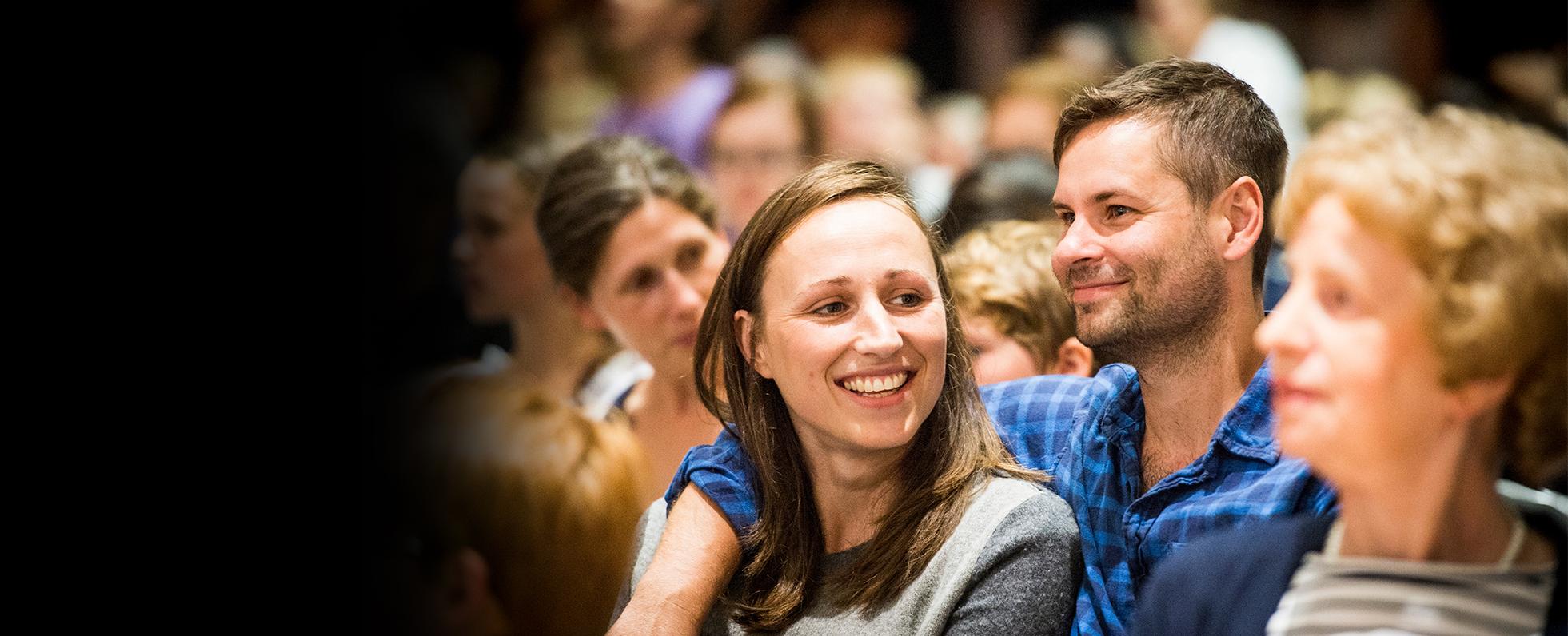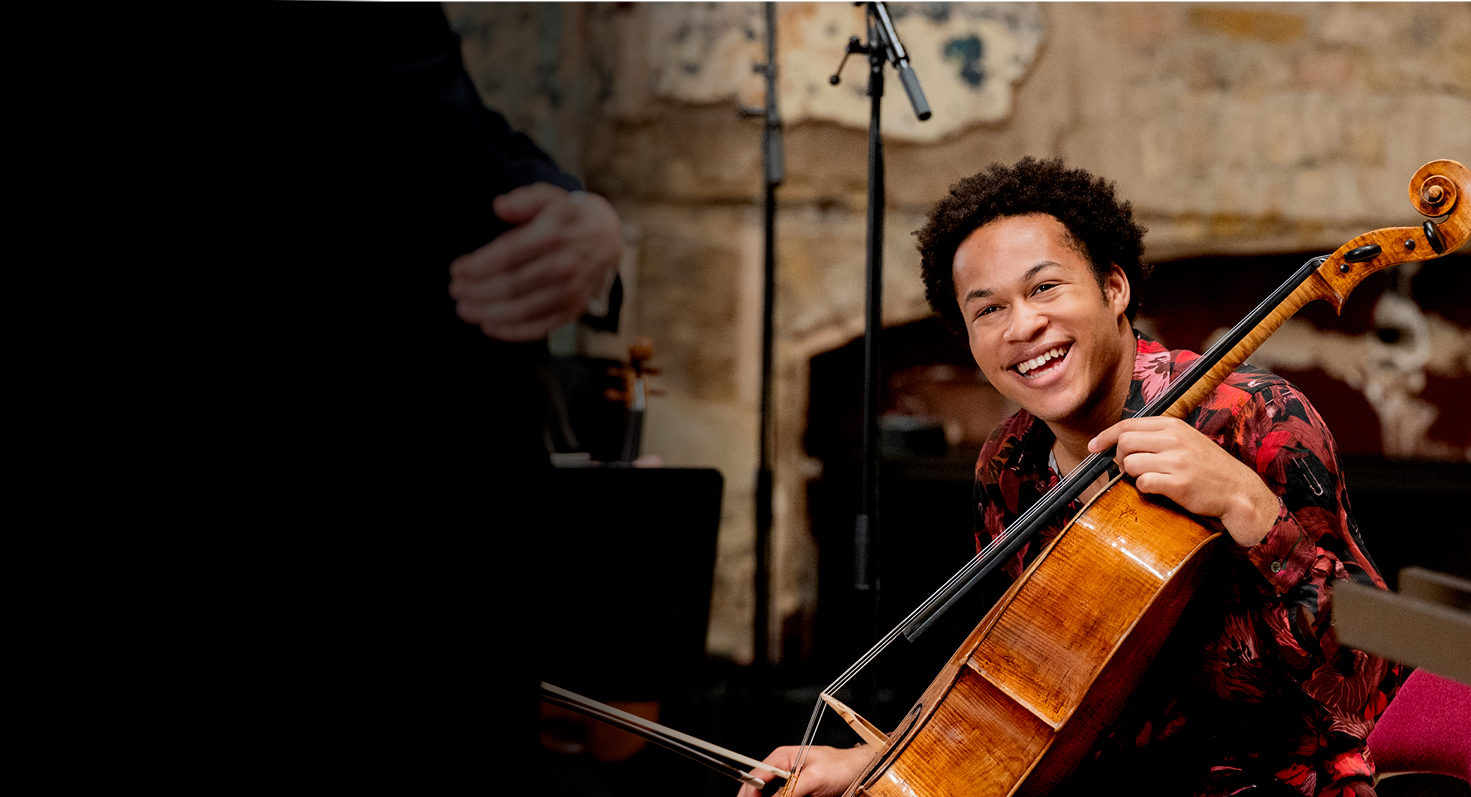Harp on the Same Nt Again and Again
Video
Instrument: Harp
In this moving-picture show, Ruth Holden introduces her instrument - the concert pedal harp.
Endowment opportunities at the Philharmonia offer supporters unique access and insights to our players. Find out more than hither:
Discover out more
Introduction
The concert harp sound is very similar to that of its relatives only more powerful and richer in tone. Although the harp has a long history information technology was not really used in orchestral music until the 19th century. What brought this about was the development of a pedalling arrangement, which enabled the player to continually change the tuning whilst playing, turning the harp into a fully chromatic musical instrument. The harp is non a particularly loud instrument just the sound of its attack does penetrate, then composers oftentimes only apply 1 with an orchestra or two with a larger orchestra.
The harp relies on vii foot pedals to modify the pitches of its 47 strings. They allow the harp to play chromatic notes but this also means that composers need to be aware of the need to allow sufficient time for pedal changes. Composers tend to use harps in a variety of means: to back up harmonies by playing chords; to add together definition to the offset of notes, phrases or bass lines – by providing a fiddling 'ping' as another instrument begins to play and to create swirls of audio through glissandos – sweeping the hands across the strings in swift, flowing movements.
Annotation
Because of the unique characteristics of the harp there are elements of the notation which are different, merely essentially the harp is notated on two staves similar the piano. Occasionally a composer will add pedal markings to the score (in particular for glissandos) but normally the harpist volition work out their own pedalling. Harpists can play only iv notes simultaneously in each paw, and 4 note chords must be close together equally the stretches become hard.
The hands to play particular notes can be markedm.d (principal droite or right hand) orone thousand.yard (main gauche or left mitt). Primal changes and chromatic notes require planning by the harpist and they need a fiddling time to modify pedals if lots of chromaticism or a complicated key-changes are called for.
Unless specified a harpist will let notes to ring until they have to be stopped (e.k. to change pedals). Certain effects characterise the harp's sound, and tin can be very constructive. Glissandos work very well, as do arpeggios and repeated figures, and harps tin can play tunesas long every bit any other instruments accept repose dynamics so the harp can be heard.
Did you know?
The neck of a harp is nether considerable pressure. At that place is most one tonne of tension in its strings.
Technique
The harp is played using the thumbs and first three fingers of each paw – harpists don't apply their little fingers every bit they're not long enough. The fingers are played at an bending to the string and every bit the fingers come up off they go into the palm of the hand. Chords on the harp are very common, merely composers must be careful to make sure they fit within the hand span of the harpist.
Root chords and first and 2d inversions are very common, but wider intervals inside chords are only possible betwixt the thumb and first finger, and not between the start and second fingers.
On the harp, the trill is very different from say, a violin. Instead of alternating betwixt two different notes a semitone apart, a harp trill is two strings, playing the same repeated note, over and over in quick succession. The consequence is that this kind of trill is much more than resonant.
Feeling creative?
Download the Philharmonia Orchestrasound sample library, suitable for making whatsoever kind of music, no matter the fashion.
Read more
Construction
The harp is a unique instrument and many elements of how it is constructed bring low-cal to how to play or write for the instrument. The modern harp has 47 strings and 7 pedals which enhance or lower each pitch-class of strings. What that means is that the harp doesn't have any 'blackness notes' similar the piano but rather pedals which sharpen or flatten each string of the aforementioned pitch.
When the pedals are raised the strings are in their flat position and the pitches of the strings are: Cb, Db, Eb, Fb, Gb, Ab, Bb, etc. When the pedals are depressed to the eye position, turning pins stretch the cord slightly, raising the pitch to a natural. Each pedal controls a different pitch and so past altering the C pedal only you would have C, Db, Eb, Fb, Gb, Ab, Bb etc. Depressing the pedal farther stretches the string even further, raising the pitch to C#, Db, Eb, Fb, Gb, Ab, Bb etc. Each pedal controls all the strings of that pitch (so by depressing the C pedal yous alter all the Cs on the harp.)
This means that harpists are constantly changing their pedal positions whilst playing the musical instrument and in the rests. Often they'll have lots of changes to brand, particularly if the piece changes key dramatically. For example if they were moving from D major (with the F and C pedals sharpened) to B major the harpist would have to sharpen 3 more sets of strings: G D and A. Pedal positions are marked in harp notation and you'll oftentimes run into harpists in an orchestra checking their pedals with their feet whilst watching the usher for their entry: if the pedals are wrong and then the audition would definitely observe!
The pedals are designed with key changes in listen so that each additional abrupt or apartment comes on the reverse side of the harp.
Harp strings are made of metal gut and sometimes nylon, and are coloured to give the histrion a visual aid to find the correct string, with all the Cs red and all the Fs black. The lowest strings are fabricated from steel and the residue of the strings are made from gut, although some players employ nylon strings for the very highest notes, as gut strings tend to break more than ofttimes.
About an hr before a concert you'll meet the harpists on stage tuning their harps – with 47 strings it can take a long time!
Explore
Why non download our iPad app, 'The Orchestra', to learn even more?
Read more
Range
The range of the harp is from C1 to G7, and the ranges autumn equally follows:
The Low Register: At the bottom of the harp unmarried notes or chords work well, simply running notes merely become a blur because this area is so resonant.
The Central Register: The central register resonates beautifully and arpeggios and brusk running notes equally well as chords fit perfectly in this register.
The Loftier Register: At the tiptop of the harp brusk running notes are improve than chords or long unmarried notes because this area is much less resonant and the notes don't band.
Frequency Range
58 Hz – 6.6 kHz
Dimension
vi'1

Video
Universe of Sound: Venus in the harp department
The Philharmonia'south largest installation, Universe of Sound, transforms a performance of Holst's The Planets into a ten-room exhibition than can fill an unabridged edifice or gallery space.
Join us on Instagram
Keep upward to appointment about online concerts, behind the scenes content and much more
Follow us

Keep up to engagement
Sign up for e-mail updates and exist the first to receive stories, films and concert announcements
Sign upward

Support the Philharmonia
Enjoyed this content? Nosotros need your help to keep these resource free
Donate now

Source: https://philharmonia.co.uk/resources/instruments/harp/
0 Response to "Harp on the Same Nt Again and Again"
Post a Comment